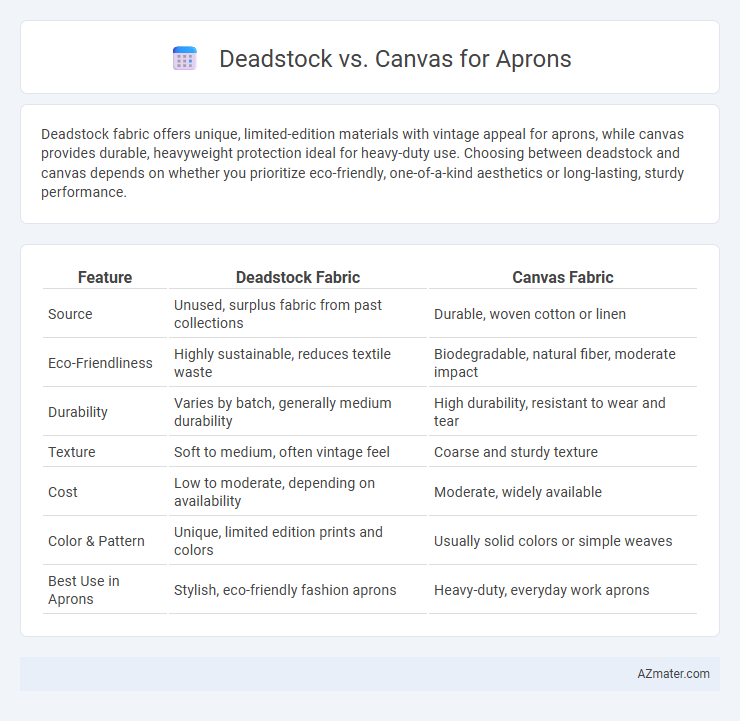Deadstock fabric offers unique, limited-edition materials with vintage appeal for aprons, while canvas provides durable, heavyweight protection ideal for heavy-duty use. Choosing between deadstock and canvas depends on whether you prioritize eco-friendly, one-of-a-kind aesthetics or long-lasting, sturdy performance.
Table of Comparison
| Feature | Deadstock Fabric | Canvas Fabric |
|---|---|---|
| Source | Unused, surplus fabric from past collections | Durable, woven cotton or linen |
| Eco-Friendliness | Highly sustainable, reduces textile waste | Biodegradable, natural fiber, moderate impact |
| Durability | Varies by batch, generally medium durability | High durability, resistant to wear and tear |
| Texture | Soft to medium, often vintage feel | Coarse and sturdy texture |
| Cost | Low to moderate, depending on availability | Moderate, widely available |
| Color & Pattern | Unique, limited edition prints and colors | Usually solid colors or simple weaves |
| Best Use in Aprons | Stylish, eco-friendly fashion aprons | Heavy-duty, everyday work aprons |
Understanding Deadstock and Canvas Fabrics
Deadstock fabric refers to unused, leftover materials from previous productions, often vintage or unique, providing sustainability and distinctive character to aprons. Canvas fabric, known for its durability and heavy-duty weave, offers excellent resistance to wear and tear, making it a popular choice for aprons requiring long-lasting protection. Understanding these fabrics helps in selecting aprons that balance eco-friendly qualities with robust performance.
Origins and Sourcing of Deadstock Material
Deadstock materials for aprons originate from unused, surplus fabric left over from previous manufacturing runs, often sourced from high-quality mills or fashion houses, ensuring unique patterns and premium textiles. Unlike canvas, which is typically produced specifically for utility and durability, deadstock fabric represents sustainable sourcing by repurposing vintage or excess materials that would otherwise go to waste. This emphasis on reusing deadstock enhances environmental sustainability and preserves the heritage of rare textiles in apron production.
What is Canvas? Key Properties and Benefits
Canvas is a durable, tightly woven fabric typically made from cotton or linen, known for its heavyweight and robust texture ideal for aprons. Key properties include high abrasion resistance, water resistance when treated, and excellent breathability, making it suitable for heavy-duty kitchen or workshop environments. Benefits of using canvas aprons encompass long-lasting wear, ease of cleaning, and superior protection against spills and stains, enhancing both functionality and comfort.
Environmental Impact: Deadstock vs Canvas
Deadstock apron fabric repurposes surplus materials that would otherwise contribute to landfill waste, significantly reducing environmental impact by minimizing resource consumption and textile waste. Canvas aprons, often made from organic cotton or recycled fibers, provide durability with a lower carbon footprint when sourced sustainably but typically require more water and pesticides during cultivation. Choosing deadstock materials leverages existing textiles, promoting circular fashion and waste reduction, while sustainably produced canvas balances longevity and eco-friendly production practices.
Durability and Longevity: Which Lasts Longer?
Deadstock fabric, often composed of tightly woven cotton or denim, offers exceptional durability due to its dense fibers and original unused condition, making it ideal for aprons requiring long-term wear resistance. Canvas, known for its heavyweight construction and rugged texture, provides superior abrasion resistance and longevity, which is why it is commonly used in workwear aprons exposed to heavy use and frequent washing. While both materials offer high durability, canvas generally outlasts deadstock fabrics in aprons subjected to continuous heavy-duty tasks and harsh conditions.
Aesthetic Appeal and Texture Differences
Deadstock fabric offers a unique, vintage aesthetic with rich textures and often features intricate patterns that enhance apron designs, creating a nostalgic, authentic look. Canvas, by contrast, provides a sturdier texture with a matte finish, offering a utilitarian appeal and durability ideal for work aprons. The interplay between deadstock's heritage charm and canvas's rugged texture caters to diverse style preferences and functional needs in aprons.
Cost Comparison: Deadstock vs Canvas Aprons
Deadstock aprons typically offer a cost-effective option due to the reuse of surplus or vintage fabric, significantly reducing material expenses compared to newly produced canvas. Canvas aprons, made from durable, freshly woven cotton or synthetic fibers, often come with higher production costs, reflected in their price. Choosing deadstock aprons supports sustainable fashion while lowering upfront investment, whereas canvas aprons provide consistency in quality and longevity at a premium price point.
Customization and Design Possibilities
Deadstock fabric offers unique patterns and textures ideal for one-of-a-kind apron designs, enhancing customization with eco-friendly, limited-edition materials. Canvas provides durable, heavy-duty fabric suited for customizable branding through screen printing, embroidery, and patches, allowing precise design elements to showcase logos or artwork. Combining deadstock's originality with canvas's strength enables aprons that balance aesthetic appeal and functional customization options.
Practical Uses in Hospitality and Home Settings
Deadstock aprons, crafted from surplus, unused fabric, offer unique textures and environmental sustainability, making them ideal for eco-conscious hospitality businesses seeking to reduce waste. Canvas aprons provide durability and resistance to stains and heat, perfect for heavy-duty tasks in busy kitchens and home cooking environments. Both materials support functional design, but deadstock suits boutique establishments valuing exclusivity, while canvas excels in high-traffic settings requiring long-lasting protection.
Making a Sustainable Choice for Aprons
Deadstock fabric, sourced from surplus materials, offers a sustainable choice by reducing waste and minimizing the environmental footprint in apron production. Canvas, known for its durability and natural fibers, supports longevity and reusability, further enhancing eco-friendly apron options. Selecting deadstock or canvas aprons promotes sustainable fashion practices by conserving resources and encouraging circular material use.

Infographic: Deadstock vs Canvas for Apron
 azmater.com
azmater.com